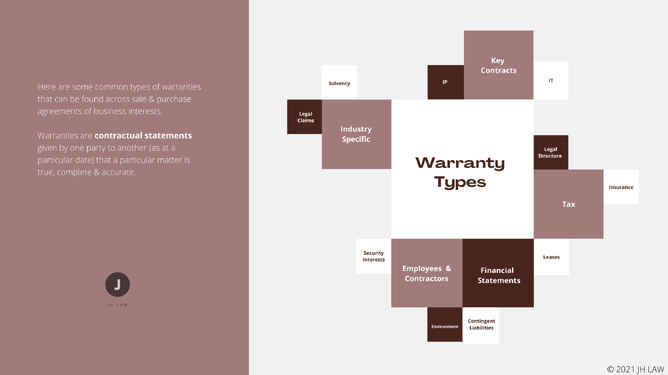Deciding which warranties & indemnities to include in a sale & purchase agreement is one of the most involved & heavily negotiated issues of a merger or acquisition (as well as the purchase price).
Generally, vendors will want to limit what warranties & indemnities they give & purchasers will want to maximise what warranties & indemnities they receive.
What is a warranty?
A warranty is a contractual statement of fact about a company, and its business, as at a particular date.
If this statement is found untrue, then the purchaser (who has the benefit of the given warranty) can seek contractual damages from the vendor. If the purchaser is successful in their warranty claim against the vendor, the vendor pays a sum to essentially put the purchaser back into its original position (had the warranty been true). However, there can be a few potential arguments such as (1) what is the original position; (2) what the purchaser already knew or (3) what the purchaser should have done to mitigate the warranty being breached etc…
Examples of Warranties
Warranties are contractual statements given by one party to another (as at a particular date) that a particular matter is true, complete & accurate.
What is an indemnity?
An indemnity is a promise of specific compensation.
Usually at the time of entering into an agreement, the vendor may have disclosed and the purchaser knows of a future risk with the business (i.e. there is a pending employment dispute that could cost the business a significant sum), but just doesn't know exactly how much it might cost them (or the business) if that risk ever came to fruition.
Indemnities are specific promises to pay (powerful for the purchaser/benefiting party) where there is less wriggle room to argue why such specific compensation may be reduced compared to a case of damages for an alleged breach of warranty.
So do consider and be very clear about what sums any indemnity is to cover (i.e. actual losses, court judgement sums and/or legal costs) and time limits of when any claims can be made.
How do you enforce warranties & indemnities using proper notice?
Notices are crucial in law! You want to follow the process correctly, or risk having to start the claim process all over again.
Search for the word “notice” or “notices” and check its surrounding and supporting clauses carefully. You want to be confident that any future process of notifying another party of their alleged breach of warranty (and/or your claim for specific compensation) is one that you can clearly and reasonably follow. Things in contracts to look for regarding these notices include:
- Who to write to?
- Do you email or post?
- Does your claim fall within or outside the agreed claim period?
- Do you need to provide receipts/proof of loss to support the claim?
- Is the amount you’re claiming within any agreed maximum claim amount?
Is it worthwhile for my business to get warranty & indemnity insurance?
It’s also worthwhile to note as an optional add-on, being W&I insurance.
Placing an W&I policy on the table, may help to address any impasse or deadlock in deal negotiations knowing that the risks of the deal are being underwritten by an insurance provider.
There are also some interesting findings from the 2020 AIG Summary Report on its most W&I reported incidents by breach type in the Asia Pacific region. Insightful!
The above is purely for informational purposes. However, reach out to Janey at janey@jhlaw.nz to determine how warranties and indemnities can apply for your proposed conveyance. No one conveyance is ever exactly the same.

